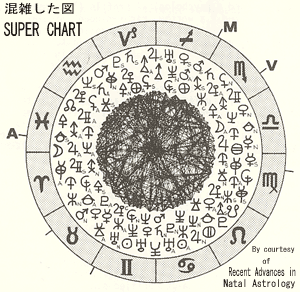ハーフサム 1・ HALF-SUM 1
石川源晃著
ハーフサムは全部で5ページです。

エバーティン (1901 – 1988) が発表したハウス方式を使用しない新しい占星学の技法ハーフサムは米国では
ミドポイントといいます。エバーティンは著書「天体の複合的な影響」のなかで、ミドポイントと言う
用語は従来のハウス方式で使用していた用語で紛らわしいから、新しい方式はハーフサムと呼ぶと明瞭に記載
しました。しかし、人々はエバーティンの意向に反し、ミドポイント
という用語で研究したので、人々はハーフサムというエバーティンが推奨した用語を使用しなくなりました。エバーティンが占星学の新しい技法のハーフサムを開発する場合に、特に強調した点はハウス方式を使用しない
事と擬似天体(実在しないで、想像で作り出した架空の天体)を使用しない事の2点でしたが、特に米国で使用されて
いるミドポイントの場合、占いの便宜上で人間が考え出した擬似天体(想像上の架空天体)を多用する占星学研究者が
多いので、エバーティンの初期の趣旨が明瞭でなくなった傾向があります。擬似天体を多用するウイッテ
に属するグループがエバーティンと同じドイツ・ハンブルグの出身ですから、擬似天体の混乱は深刻なものです。
擬似天体(架空天体)を推進する人々の意見によれば、1781年に天王星が発見される以前に、占星学の研究者たちは経験的に
未発見の天体の存在を予測していて、その予測場所の非常に近くで新天体の天王星が発見されたと主張しています。
New system that has rejected the use of house system is developed by Reinhold Ebertin (1901 – 1988). As
he wrote in his book “The Combination of Stellar Influences” that the word MID-POINT had been used in
the previous house system, he did not recommend to employ this old word for his new system but he preferred
to employ a new word HALF-SUM for his new system promoted. Contrary to his original recommendation,
people that developed the use of Ebertin system of astrology have all employed the word MID-POINT that
we now popularly find the word MID-POINT for Ebertin system instead of his recommended word HALF-SUM.
There were two major points that Reinhold Ebertin had emphasized in the use of his new system or Half-Sum.
First was to abandon completely the use of any type of house system in astrology. Second was to avoid the use
of any kind of hypothetical planets or a dummy planet that is set by human for the convenience of practical
prediction performed. The confusion aroused in the hypothetical planets was originated by the group of
Alfred Witte (1878 – 1941) who came from the same locality of Ebertin that is located in Hamburg Germany.
Believers in the hypothetical planets are fond of the story of discovery of new planet Uranus in 1781. Before
that moment, many astrologers were using a hypothetical planet in place of Uranus. Astronomer could allocate
new planet Uranus after they observed the sky very close to the hypothetical planet of astrologers employed.

擬似天体(架空天体)の設定に反対の理由は占星学で取り扱う占星点の数を増加すると
ホロスコープが多数の占星点で混雑するというのです。(左図の混雑図を参照)
現在、占星学で取り扱う占星点は太陽系の実在する天体10個のほかにASCとMCという計算上の占星点を
使用しますから、最小限12個の点について、コンジャンクション、スクエアー、トライン、オポジッションの
重要なアスペクトを考慮しています。このうち、コンジャンクションとオポジッションは360度につき1回だけですが、
スクエアーとトラインは360度につき2回存在します。各点のオーブを5度とすれば、各点を含む10度の間は各点に
占拠されることになります。ですから全天空の360度に対して、占星点が影響する度数が720度になります。
実際には天体同士が狭い位置に偏ることで、わずかな隙間ができますが、擬似天体(架空天体)を増設すれば、
隙間なしに占星点が配置されることになります。擬似天体(架空天体)を設置するよりは、小惑星やドラゴン・ヘッド
などの実績がある占星点を優先的に使用すべきであるという意見もあります。
Reason for placing the limit to the number of hypothetical planets is a crowded horoscope. (See SUPER CHART in the left view)
A horoscope contains astrological points of ASC, MC and ten major moving bodies equipped. As we give
five-degree-orb for each point, ten degrees fir each point will be occupied. Considering the aspects of conjunction
and opposition, we must set aside 240 degrees out of 360 degrees horoscope prepared. As the square and trine
are counted twice in the whole circle, we need another 480 degrees. As the most of astrological points are located
in uneven distribution, we can find a vacant space in the horoscope. By applying hypothetical planets, however,
the chart will be crowded with many points and there will be no other vacancy to place either Asteroids or
Dragon-head of well recognized useful points experienced.


